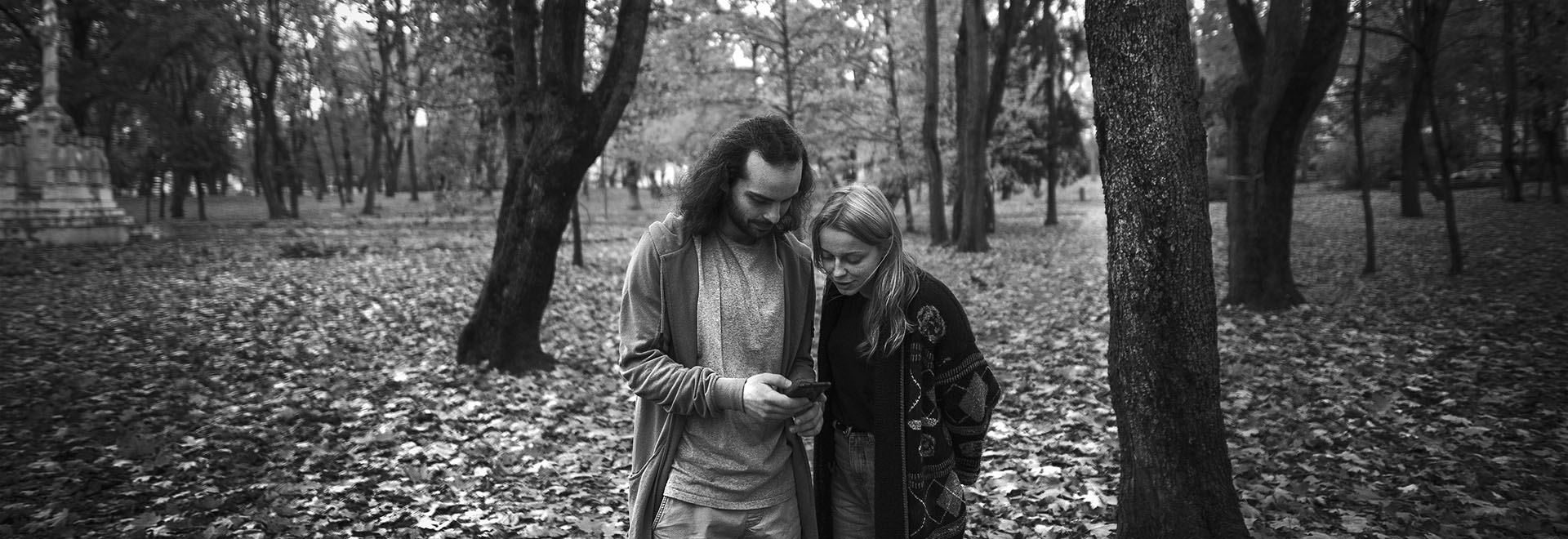Find and Seek
A map and street art based game about complex history of the Old Kaunas cemetery

 1
1Navigate
You can play at any time, smartphone is all you need. Game will take 1 hour. Scroll down to find a map in this page.
 2
2Read
Read the authentic stories from the local people once you reach a point on the map.
 3
3Connect
Ponder which of the accounts fits the point which you are standing at, and assign it in the answer form.
 4
4Reclaim
After sending the answers go to Kaunas 2022 office at Laisvės al. 36 to take back the prize.
What's in the gift?
- Kaunas 2022 merchandise
- Caffeine coupon for coffee
- 16 GB USB memory stick
- The first 15 will additionally receive a unique present
The contents of USB memmory stick
- Never seen before information gathered during one year long research about Ramybės park
- Never seen before short documentary "Piece: Between Park and a Cemetery"
- The sketches made by Tadas Šimkus for the street art pieces
- Many more little things
To get the gift...
- You have to be one of the first 30 who successfully solves the game
- You have to fill your true email into the form
- You have to come to Kaunas 2022 office during its working hours: I-V 9:00 - 18:00
More about the game
The Old Kaunas cemetery, also known as The Park of Calmness / Peace (“Ramybės parkas”), is a place packed with hundreds of years of complex history. Here the passersby are wading through thick rivers filled with memories, where each meter is vibrating with a potential to speak out. Somewhere are children playing with bones, somewhere else is a girl’s body turning into dust, elsewhere – the pioneer of Swedish modernist literature teaching Lithuanian poets to drink tea with brandy. “Find and seek” is an art and storytelling puzzle. It is solved by walking around the park and uncovering the troublesome historicity of it. All you need to play is curiosity and a smartphone with internet connection.
Stories
1. Body turned into dust
One family here buried a girl who died very young due to some illness. When the mother opened her coffin during the relocation of the cemetery she found her daughter lying there like she was just asleep. She was very, very beautiful. A lot of people were working around at the time, so there was a lot of eyes who saw it. This incident was a big deal. Just when the mother touched the girl, she instantly became alive for a second, kissed her mom in the forehead and turned into dust, while her long, beautiful hair remained loose in the coffin. Everyone then saw her mother brushing the hair, and crying with every swipe...
2. The icon of Surdegiai
Once there was a place called Surdegiai near Panevėžys where a male monastery stood. One of the monks had a vision there. He heard words from heaven: "Come to the spring and find me". He came there and found this icon of Mary dating back to 1530. The icon now has a brass cover which were not there at its time. The icon used to have very many votive offerings which are a form of expressing the gratitude to the saint. These are various jewelry usually having a shape of eyes, hands or feet. There were so many of them that it was decided to melt everything and decorate the icon with bindings. This icon is magical and has great Holiness. It is an honor for us to have it inside our sanctuary. It enhances our daily prayer.
3. Tricolor out of scarves
The commemoration of the Saints Day in 1956 was an extremely powerful event. Thousands of people came together and sang folk songs. As the crowd began to chant in unison "Freedom! Freedom! Freedom!” and clap, people noticed that Lithuanian flag was missing. Then one young man climbed on the monument and asked for green, red and yellow scarves. The crowd began shouting "Green, Red, Yellow!". Soon, a tricolor was strapped from the scarves and tied with a trouser belt at the top of the monument.
4. Tea with vodka
Indeed, no other drunkards are more horrifying than Lithuanian poets, and hey have received me with open arms. I taught them how to drink and tefritchar [tea with vodka]. It seems to have an unusually strong effect on non-Finns. I remember a humorously awkward situation last week when I had to align a group of youngsters into a long line, leaning them against lantern poles on the main street of Kaunas, and then running to catch a car that could take them from there. They stood obediently, clinging to the pillars with all their might and falling occasionally.
5. The magic grave
People speak that a father who is seriously offended by the Sixth Commandment is buried in this place. When he died, he was convinced that he had been tempted to sin by the serpent who had seduced him, just as Eve was, that's why a sculpture of serpent was once made for him. Gypsies see this tomb as magical. They often come here with crosses, do magic rituals with cards. The branches of nearby trees often have a lot of crows. It is said that they escort souls to eternity. Apparently, this man's ghost is still wandering somewhere among the living, because crows are still waiting for him…
6. Commemoration of the Saints Day at the monument
You can't even imagine how many people were in this cemetery during that great commemoration of the Saints Day. There was a particularly powerful spectacle at the monument. The people who climbed on it and stood nearby shouted openly that we needed freedom, that we needed to fight, that we supported the Hungarian fight for freedom. One woman spoke very sharply, and instantly after that she was quickly grabbed and pulled away by someone. My temper couldn't hold, I said: "Men, there are so many of us, are we going to let her go?", and the crowd quickly took her back from the militia. But then I felt that now they are taking me. On one side is a militiaman, on the other - a big, red faced young Komsmol guy. I got fierce, took all my rage and smashed the militiaman in the head. He started searching for his hat and released me, then I ripped away from the Komsomol guy, and I was pulled back by the crowd. It took an hour and things got even more intense there. People marched away from the cemetery through Vytautas Avenue. The whole street was full, you couldn't see the end.
7. The construction
In Tsarist times, the current Ramybės park was divided into four denominations: Catholic, Orthodox, Tatar and Muslim. On this land we had a wooden mosque, an imam's house, a school and a garden. When the anniversary of the death of Vytautas the Great was commemorated in 1930s, the Lithuanian government together with the Muslim community decided to build a brick mosque. Everybody realized at that time how important the contribution of different nations was to the creation of Lithuania. Tolerance was a common sense, nobody needed to discuss it. The construction of the mosque showed how strong was the attempt to create together. The construction was completed in 1933. The mosque worked for some years, but then it was shut down during World War II and changed many times inside. There used to be a circus and a library there. However, from the outside the building is unchanged.
8. Games with bones
Trys mokyklos buvo išsidėsčiusios aplink kapines ir mes dar būdami mokiniai viską matėme iš labai arti. Paaugliai vaikinai negalėjo praleisti tokio įvykio. Ėmė raustis po kapus, į pamokas atsinešdavo kaulų, taip gąsdindavo mergaites. Drąsesni lįsdavo gilyn į kapus. Susiradę kokių nors smulkmenų – kryželį, žiedą – viešai demonstruodavo. Tai buvo bene baisiausias Kauno miesto laikotarpis, kuris pamokas pavertė groteskiškais paradais. Įsivaizduokit – tu sprendi matematiką, o už lango kasa palaikus.
Three schools were located around the cemetery. We saw everything from a very close distance when we were students. The teenage guys couldn't miss such an event. They began to loot the graves bringing bones to the lessons and frightening the girls. Those who had more courage went deeper into the graves. They publicly bragged about it once they found some triffles like a cross or a ring there. It was probably the most gruesome period of Kaunas city, which turned school lessons into the parades of grotesque. Just imagine: you are having test in mathematics while people are digging the graves behind the window.
9. The account of the elder
I am standing here for about 100 years already. I am the offspring of others like me who owned this land until recently. This place used to be a very viscous swamp for millennia, filled with various creatures. Frogs roared, birds fluttered. I was told, I know. Then the death began to be celebrated here. That I witnessed myself. But man is a very iffy being and has brought these celebrations to an end. For half my life it is calm here and nothing happens. However, recently there was a terrible massacre here. Many of my old friends have fallen. Now it is brighter here, less of a danger to people, but I feel way more sadness. I would like to see all this territory being given back to my family.
10. Hiding the coffins
Kai čia vaikščiodavau, dar stovėjo Dariaus ir Girėno mauzoliejus. Aš buvau nulipusi pažiūrėti, bet ten buvo tuščia, nebebuvo karstų. Juos mačiau medicinos institute, į kurį įstojau 1945 m. Ruso laiku ten buvo koplyčia, kurioje jie ir stovėjo. Kai užėjo vokiečiai, medicinos institutą uždarė ir prie jo pastatė sargybinius, matyt, įtardami apie karstus. O juk Darių ir Girėną numušė vokiečiai. Tuo metu aš jau buvau baigusi institutą ir ten dirbau pas profesorių Šiaulį, kuris katedroje pusiau gyveno. Vieną dieną ateinu, tų karstų nebėra, galvoju – jau likvidavo vokiečiai. Pasirodo prof. Šiaulis su kūriku Rauba pasikvietė vokiečių sargybinius, nugirdė juos spiritu iš farmacinės chemijos katedros, privaišino lašinukais, per tą laiką iškalė vietą sienoje ir sukišo į ją tuos du karstus. Užtinkavo ir viskas. Karstai dingo.
When I walked here, the mausoleum of Darius and Girėnas was still standing. I descended to see what's inside, but it was empty, there were no coffins. I saw them at the Institute of Medicine, which I joined in 1945. In Russian times there was a chapel inside where they stood. When the Germans came in, the medical institute was closed and guards were placed near it, perhaps having a suspicion about the coffins. After all, it was Germans who killed Darius and Girėnas. At that time, I was already graduating from the institute and working there with professor Šiaulys, who was almost living at the department. One day when I came I saw that the coffins were gone. I thought that the Germans have finally liquidated them. However, the story was different as I later found out. Apparently professor Šiaulys and the stoker Rauba invited the German guards inside, made them incredibly drunk with alcohol from the Department of Pharmaceutical Chemistry, catered them with fresh meat, and in the meantime carved a hole in the wall and swung the two coffins inside of it. That was it. The coffins were gone.
The author of the game - Gytis Dovydaitis; the author of street art pieces - Tadas Šimkus; project was initiated by Memory Office.